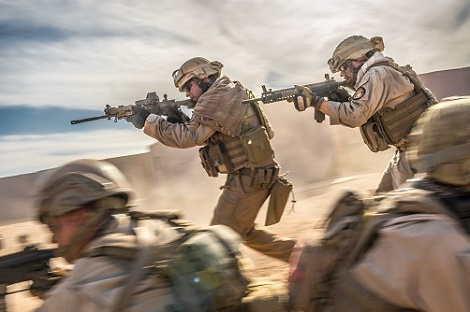Take Down Terrorists in Arizona
Desert Wolf Tours Elite Combat Simulator Lets Civilians be Soldiers
Have you ever wanted to be part of an elite military operation, taking down terrorists and rescuing hostages? Well, among the ATV tours and shooting ranges of Desert Wolf Tours in New River, AZ, you can get the full military experience with the Elite Combat Simulator.
 “The Elite Simulator provides our guests the chance to become a Tier 1 Operator,” says Mike Simpson, Director of Tactical Training. This is the military term for special operations forces with covert operations and counterterrorism capabilities, much like the famous Seal Team 6. “They’re the elite of the elite.”
“The Elite Simulator provides our guests the chance to become a Tier 1 Operator,” says Mike Simpson, Director of Tactical Training. This is the military term for special operations forces with covert operations and counterterrorism capabilities, much like the famous Seal Team 6. “They’re the elite of the elite.”
It’s designed to give civilians a chance to fulfill fantasies, ranging from people who wanted to join the military but couldn’t to people who want to know what it’s like to be in a video game. “It’s more than paintball; it’s more than airsoft. It really gets the blood pumping,” says Hunter Corbier, the General Manager.
Thankfully, it’s not something you have to have military training to participate in. Simpson and his staff will train you in everything, from safety and equipment to ropes courses and breaking down doors. “I’ve been conducting military training for the past 17 years. A lot of my staff have been involved in these sorts of operations.” But the training is intense, lasting between 4 ½ to 5 hours before the three missions even begin, and often involve a lot of being shouted at by instructors.
Simpson calls this Stress Inoculation, and it gives guests an idea of which role each member of your team is best suited for. “We’re putting them in stressful conditions to discover what their personalities are under pressure,” he says. “During the ropes course, we start looking for people who have attention to detail, leadership skills, weapon experience, etc.”
 Don’t think it’s just for boys, though. Simpson says they once had a family reunion that was half men and half women. “The men were bragging, saying they would show the women how it’s done, but the dynamics of the group changed once the training started.” He notes that the women were easier to train because they had no preconceived notions, which made them more attentive and willing to learn.
Don’t think it’s just for boys, though. Simpson says they once had a family reunion that was half men and half women. “The men were bragging, saying they would show the women how it’s done, but the dynamics of the group changed once the training started.” He notes that the women were easier to train because they had no preconceived notions, which made them more attentive and willing to learn.
After the training is done, the missions begin. The three levels range in difficulty. The first one is the easiest because no one is shooting at you, and Simpson says it’s virtually impossible to fail unless the team wastes time by fighting amongst themselves. The second mission is more intense, with role-players creating obstacles and gunfire, but still not actually shooting at you. The third mission is the hardest, where your team is not only being fired at, but also has to fulfill the two objectives of gathering intel and protecting hostages.
Don’t worry about getting shot, as Corbier assures that these terrorists are only firing airsoft guns. Meanwhile, participants use AR-15 rifles, which are heavily modified so they can only use ammo called Ultimate Training Munitions, which are small rounds made of a wax-like material, similar to lipstick surrounded by a plastic cage. On impact, the wax-like material leaves a mark, indicating a hit, not unlike paintball. “It’s very accurate, very realistic because it is a real weapon. But it’s physically impossible to chamber a live round.” Along with the rifle, they provide everything from the uniform pants and shirt to the equipment. “Other than your boots and your sunglasses, we supply all the gear.”
 And while the Elite Combat Simulator is hard, the staff takes care not to make things impossible. “We take into account different physical abilities and difficulties they might have,” says Simpson. “We do have some guests who say ‘Hey, give us the works,’ so they’ll have to carry out injured hostages and have gunfire coming down on them.”
And while the Elite Combat Simulator is hard, the staff takes care not to make things impossible. “We take into account different physical abilities and difficulties they might have,” says Simpson. “We do have some guests who say ‘Hey, give us the works,’ so they’ll have to carry out injured hostages and have gunfire coming down on them.”
Corbier adds, “These are all private events, so you’re not going to have different groups with conflicting difficulties.”
Your team doesn’t get any fabulous prizes for completing the missions, but you do get to see how you matched up to past teams. “We motivate the participants by showing them scores. There really aren’t any prizes; just the sense of accomplishment of seeing where they fall in the scoring system,” says Simpson. The scores are made up of factors such as how fast you completed the objective, difficulty, point values for things like headshots, and more. “It gives people a level of respect, where they can say ‘Wow, we did that in 9 minutes. With a little more practice we could do even better.’”
-By Ettractions Digital Content Editor ALLISON BENNETT

You are not logged in. To login or create an account please click here